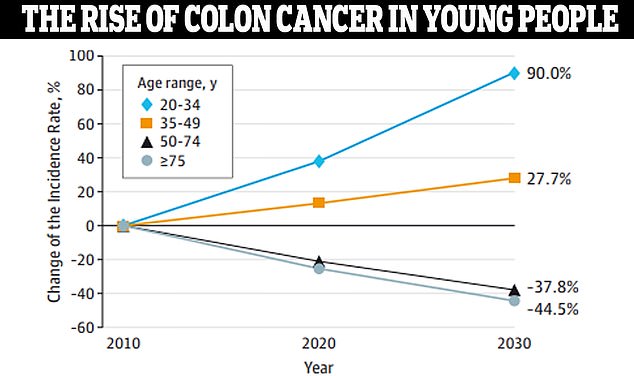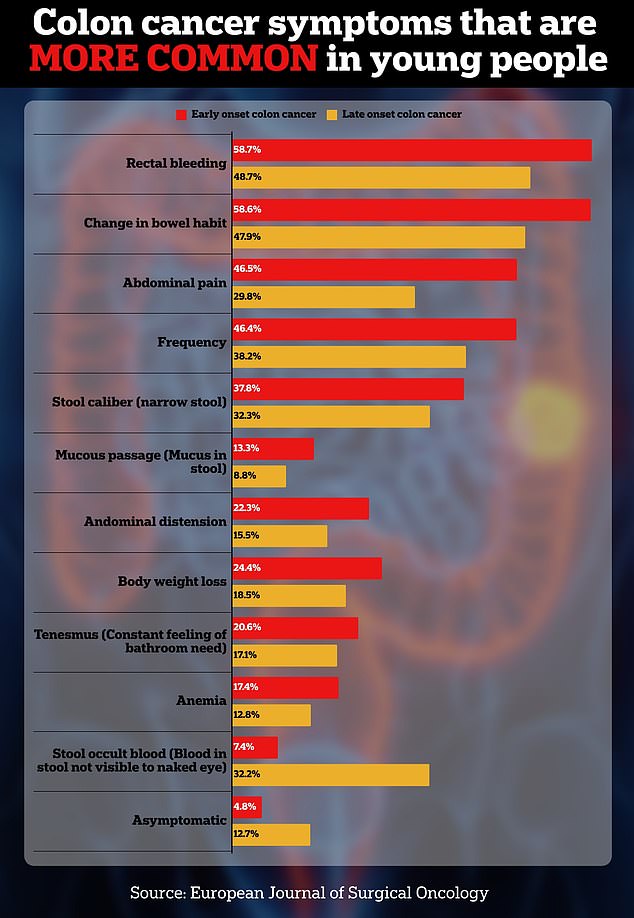Condition that affects 100 million Americans increases risk of early colon cancer by up to 65%
New research may have discovered an unexpected driver behind the mysterious increase in cases of colon cancer in young people.
The study found that patients with high blood sugar were up to 65 percent more likely to be diagnosed with cancer before the age of 50 than their peers.
Diabetics were most at risk, but people with prediabetes – where blood sugar levels are higher than normal but not high enough to be classified as diabetes – were also at increased risk.
About 100 million Americans and 5 million people in Britain have prediabetes, which can increase their risk of cancer because excess glucose feeds cancer cells and causes inflammation linked to tumor growth.
Experts who analyzed the medical records of more than 500,000 people as part of the study are now calling for ‘tighter glucose control’ to be made a priority for young people.
The above graph shows the increase in colorectal cancer in Americans under the age of 50 over the past twenty years

Data from JAMA Surgery shows that colorectal cancer is expected to increase by 90 percent in people aged 20 to 34 by 2030
The US has the sixth highest rate of early-onset cancer (87 cases per 100,000 people) and colon cancer is among the fastest rising.
The number of diagnoses among people under 50, who are classified as early-onset, is expected to increase by 90 percent between 2010 and 2030 in people aged 20 to 34.
Experts have tried to blame everything from ultra-processed ingredients to a change in the body’s microbiome: the collection of beneficial bacteria in the gut.
But now scientists may have found a link between blood sugar levels and colon cancer.
Blood sugar levels are the amount of glucose in your blood. Glucose is a type of sugar that comes from food and is the body’s primary source of energy.
A normal blood glucose range is 70 to 99 milligrams per deciliter (mg/dL).
Levels between 100 and 125 mg/dl are considered prediabetic, and anything from 126 mg/dl or higher classifies a person as having type 2 diabetes.
However, a person can have higher than normal glucose levels, a condition called hyperglycemia, without diabetes.
Some causes may include a diet high in carbohydrates and sugar, lack of physical activity, obesity, physical trauma, infections, stress, certain medications and other medical conditions such as pancreatic diseases, Cushing’s syndrome and polycystic ovary syndrome.
Symptoms of hyperglycemia include extreme thirst, frequent urination, recurring infections, weight loss, and blurred vision.
The studyconducted by a group of researchers from Beijing, the Chinese Academy of Sciences and Beijing Union Medical College, among others, generally showed that higher blood glucose levels were associated with an increased risk of developing CRCs.
The link was strongest between diabetes blood sugar levels and early-onset colon cancer.
When comparing blood glucose levels and risk of early-onset bowel cancer, levels above 126 mg/dl were associated with a 61 percent increased risk of early-onset CRC compared with people with levels below 126 mg/dl in the UK cohort.
For late-onset CRC, diabetes glucose levels were associated with a 14 percent higher risk.
Among the Kailuan cohort, glucose levels greater than 126 mg/dL were associated with a 65 percent increased risk of early-onset colorectal cancers and a 25 percent increased risk of late-onset CRCs.

The above shows the symptoms and their frequency in early-onset patients, in patients who develop colon cancer before the age of 50, and in late-onset patients, in patients who develop the cancer after age 50.
The researchers, whose study was published in the Journal of the National Cancer Center, said their results suggest that “tighter glucose control should be a priority for younger age groups.”
There were several reasons the researchers gave for the link between blood sugar levels and colorectal cancer.
First, high glucose levels can directly damage DNA and promote the proliferation of damaged cells.
It can also facilitate the migration and invasion of cancer cells throughout the body.
Second, cancer cells use glucose, causing increased levels in the body to provide the cells with more energy.
High blood sugar also interrupts certain signals in the body that can stimulate the growth and movement of cancer cells.
Finally, the study states that elevated glucose levels have been linked to chronic stress and inflammation in the body, which may contribute to cancer.
The researchers wrote that the increase in early-stage colon cancers represents a “significant cancer burden among young adults… (and) the causes of this troubling trend are not well understood.”
The team wrote: ‘…our findings underscore the need for greater public health efforts targeting obesity, metabolic dysfunction, and hyperglycemia as part of a multifaceted approach to alleviating the growing burden of colorectal breast cancer, especially among younger age groups.’
Experts aren’t sure what’s causing the rise in early-onset cancers, but say it could be the result of a high-meat, high-fat diet, the rise of obesity or exposure to ultra-processed foods. artificial ingredients and additives. as well as harmful chemicals.
One factor previously considered behind the increase was previous antibiotic use. However, a new, separate one study in the journal Clinical Gastroenterology and Hepatology, found that the few studies examining this association reported conflicting results.
California researchers looked at the medical records of 4.5 million patients in the state’s Kaiser Permanente health care system, analyzing the records of 18- to 49-year-olds diagnosed with early-onset colon cancer between 1998 and 2020 with a history of taking oral antibiotics.
The results showed that an association between previous antibiotic use in adulthood and the occurrence of CRC in young adulthood was not statistically significant.
Separate research from the University of Missouri-Kansas City looked at the number of cases of colorectal cancer in people aged 10 to 44 over the past two decades and found that the number of cases had risen in all age groups.
The rate of colorectal cancer grew by 500 percent among children aged 10 to 14 and by 333 percent among teenagers aged 15 to 19.
Rates rose 71 percent among people aged 30 to 34 to seven cases per 100,000 people. And among people aged 35 to 39, the rates rose by 58 percent to 12 cases per 100,000 people.
According to the ACS, 37 percent of colorectal cancers occur in people under age 50, compared to 24 percent in people age 65 or older.
And the number of CRCs has increased by two percent among people under age 55 since the mid-1990s, and the number of deaths has increased by one percent since the mid-2000s.
The five-year survival rate for CRCs is 64 percent, but that drops to 14 percent if the cancer has spread, which is common in early-onset cases because symptoms are often not present or misdiagnosed until the cancer spreads through the body has spread.
Symptoms include changes in toilet habits, blood in the stool, weakness, fatigue, nausea, loss of appetite, a lump in the abdomen or rectum, diarrhea, abdominal cramps, constipation and vomiting.
